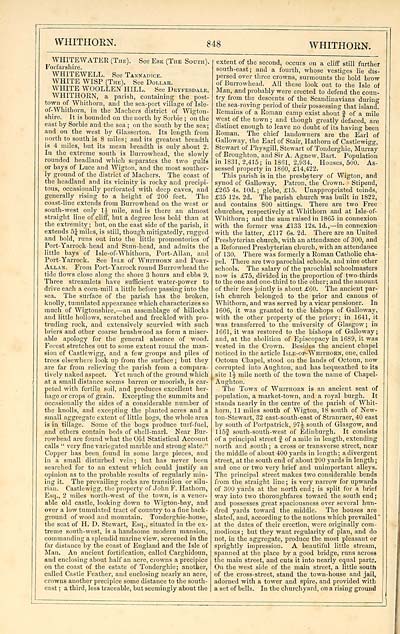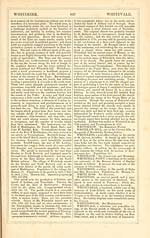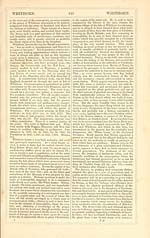Download files
Complete book:
Individual page:
Thumbnail gallery: Grid view | List view

WHITHOEN.
848
WHITHOEN.
WHITEWATER (The). See Esic (The South).
Forfarshire.
WHITEWELL. See Tannadice.
WHITE WISP (The). See Dollar.
WHITE WOOLLEN HILL. See Dryfesdale.
WHITHOEN, a parish, containing the post-
town of Whithorn, and the sea-port village of Isle-
of-Whithorn, in the Machers district of Wigton-
shire. It is bounded on the north by Sorbie ; on the
east by Sorbie and the sea ; on the south by the sea;
and on the west by Glasserton. Its length from
north to south is 8 miles; and its greatest breadth
is 4 miles, but its mean breadth is only about 2.
In the extreme south is Burrowhead, the slowly
rounded headland which separates the two gulfs
or bays of Luce and Wigton, and the most souther-
ly ground of the district of Machers. The coast of
the headland and its vicinity is rocky and precipi-
tous, occasionally perforated with deep caves, and
generally rising to a height of 200 feet. The
coast-line extends from Burrowhead on the west or
south-west only li mile, and is there an almost
straight line of cliff, but a degree less bold than at
the extremity ; but, on the east side of the parish, it
extends Similes, is still, though mitigatedly, rugged
and bold, runs out into the little promontories of
Port- Yarrock- head and Stun-head, and admits the
little bays of Isle-of- Whithorn, Port-Allan, and
Port- Yarrock. See Isle of Whithorn and Port-
Allan. From Port- Yarrock round Burrowhead the
tide flows close along the shore 3 hours and ebbs 9.
Three streamlets have sufficient water-power to
drive each a corn-mill a little before passing into the
sea. The surface of the parish has the broken,
knolly, tumulated appearance which characterizes so
much of Wigtonshire, — an assemblage of hillocks
and little hollows, scratched and freckled with pro-
truding rock, and extensively scurvied with such
briers and other coarse brushwood as form a miser-
able apology for the general absence of wood.
Forest stretches out to some extent round the man-
sion of Castlewigg, and a few groups and piles of
trees elsewhere look up from the surface ; but they
are far from relieving the parish from a compara-
tively naked aspect. Yet much of the ground which
at a small distance seems barren or moorish, is car-
peted with fertile soil, and produces excellent her-
bage or crops of grain. Excepting the summits and
occasionally the sides of a considerable number of
the knolls, and excepting the planted acres and a
small aggregate extent of little bogs, the whole area
is in tillage. Some of the bogs produce turf-fuel,
and others contain beds of shell-marl. Near Bur-
rowhead are found what the Old Statistical Account
calls " very fine variegated marble and strong slate."
Copper has been found in some large pieces, and
in a small disturbed vein ; but has never been
searched for to an extent which could justify an
opinion as to the probable results of regularly min-
ing it. The prevailing rocks are transition or Silu-
rian. Castlewigg, the property of John F. Hathom,
Esq., 2 miles north-west of the town, is a vener-
able old castle, looking down to Wigton-bay, and
over a low tumulated tract of country to a fine back-
ground of wood and mountain. Tonderghie-house,
the scat of H. D. Stewart, Esq., situated in the ex-
treme south-west, is a handsome modern mansion,
commanding a splendid marine view, screened in the
far distance by the coast of England and the Isle of
Man. An ancient fortification, called Carghidoun,
and enclosing about half an acre, crowns a precipice
on the coast of the estate of Tonderghie; another,
called Castle Feather, and enclosing nearly an acre,
crowns another precipice some distance to the south-
east ; a third, less traceable, but seemingly about the
extent of the second, occurs on a cliff still further
south-east; and a fourth, whose vestiges lie dis-
persed over three crowns, surmounts the bold brow
of Burrowhead. All these look out to the Isle of
Man, and probably were erected to defend the coun-
try from the descents of the Scandinavians during
the sea-roving period of their possessing that island.
Remains of a Roman camp exist about § of a mile
west of the town ; and though greatly defaced, are
distinct enough to leave no doubt of its having been
Roman. The chief landowners are the Earl of
Galloway, the Earl of Stair, Hathom of Castlewigg,
Stewart of Physgill, Stewart of Tonderghie, Murray
of Broughton, and Sir A. Agnew, Bart. Population
in 1831, 2,415; in 1861, 2,934. Houses, 500. As-
sessed property in 1860, £14,422.
This parish is in the presbytery of Wigton, and
synod of Galloway. Patron, the Crown. Stipend,
£265 4s. lOd. ; glebe, £15. Unappropriated teinds,
£35 12s. 2d. The parish church was built in 1822,
and contains 800 sittings. There are two Free
churches, respectively at Whithorn and at Isle-of-
Whithorn ; and the sum raised in 1865 in connexion
with the former was £133 12s. Id., — in connexion
with the latter, £117 6s. 2d. There are an United
Presbyterian church, with an attendance of 300, and
a Reformed Presbyterian church, with an attendance
of 130. There was formerly a Roman Catholic cha-
pel. There are two parochial schools, and nine other
schools. The salary of the parochial schoolmasters
now is £75, divided in the proportion of two-thirds
to the one and one-third to the other; and the amount
of their fees jointly is about £60. The ancient par-
ish church belonged to the prior and canons of
Whithorn, and was served by a vicar pensioner. In
1606, it was granted to the bishops of Galloway,
with the other property of the priory; in 1641, it
was transferred to the university of Glasgow ; in
1661, it was restored to the bishops of Galloway;
and, at the abolition of Episcopacy in 1689, it was
vested in the Crown. Besides the ancient chapel
noticed in the article Isle-of-Whithorn, one, called
Octoun Chapel, stood on the lands of Octoun, now
corrupted into Aughton, and has bequeathed to its
site 1J mile north of the town the name of Chapel-
Aughton.
The Town of Whithorn is an ancient seat of
population, a market-town, and a royal burgh. It
stands nearly in the centre of the parish of Whit-
horn, 11 miles south of Wigton, 18 south of New-
ton-Stewart, 32 east-south-east of Stranraer, 40 east
by south of Portpatrick, 97 J south of Glasgow, and
115f south-south-west of Edinburgh. It consists
of a principal street f of a mile in length, extending
north and south ; a cross or transverse street, near
the middle of about 400 yards in length ; a divergent
street, at the south end of about 200 yards in length ;
and one or two very brief and unimportant alleys.
The principal street makes two considerable bends
from the straight line ; is very narrow for upwards
of 300 yards at the north end ; is split for a brief
way into two thoroughfares toward the south end;
and possesses great spaciousness over several hun-
dred yards toward the middle. The houses are
slated, and, according to the notions which prevailed "
at the dates of their erection, were originally com-
modious; but they want regularity of plan, and do
not, in the aggregate, produce the most pleasant or
sprightly impression. A beautiful little stream,
spanned at the place by a good bridge, runs across
the main street, and cuts it into nearly equal parts.
On the west side of the main street, a little south
of the cross-street, stand the town-house and jail,
adorned with a tower and spire, and provided with
a set of bells. In the churchyard, on a rising ground
848
WHITHOEN.
WHITEWATER (The). See Esic (The South).
Forfarshire.
WHITEWELL. See Tannadice.
WHITE WISP (The). See Dollar.
WHITE WOOLLEN HILL. See Dryfesdale.
WHITHOEN, a parish, containing the post-
town of Whithorn, and the sea-port village of Isle-
of-Whithorn, in the Machers district of Wigton-
shire. It is bounded on the north by Sorbie ; on the
east by Sorbie and the sea ; on the south by the sea;
and on the west by Glasserton. Its length from
north to south is 8 miles; and its greatest breadth
is 4 miles, but its mean breadth is only about 2.
In the extreme south is Burrowhead, the slowly
rounded headland which separates the two gulfs
or bays of Luce and Wigton, and the most souther-
ly ground of the district of Machers. The coast of
the headland and its vicinity is rocky and precipi-
tous, occasionally perforated with deep caves, and
generally rising to a height of 200 feet. The
coast-line extends from Burrowhead on the west or
south-west only li mile, and is there an almost
straight line of cliff, but a degree less bold than at
the extremity ; but, on the east side of the parish, it
extends Similes, is still, though mitigatedly, rugged
and bold, runs out into the little promontories of
Port- Yarrock- head and Stun-head, and admits the
little bays of Isle-of- Whithorn, Port-Allan, and
Port- Yarrock. See Isle of Whithorn and Port-
Allan. From Port- Yarrock round Burrowhead the
tide flows close along the shore 3 hours and ebbs 9.
Three streamlets have sufficient water-power to
drive each a corn-mill a little before passing into the
sea. The surface of the parish has the broken,
knolly, tumulated appearance which characterizes so
much of Wigtonshire, — an assemblage of hillocks
and little hollows, scratched and freckled with pro-
truding rock, and extensively scurvied with such
briers and other coarse brushwood as form a miser-
able apology for the general absence of wood.
Forest stretches out to some extent round the man-
sion of Castlewigg, and a few groups and piles of
trees elsewhere look up from the surface ; but they
are far from relieving the parish from a compara-
tively naked aspect. Yet much of the ground which
at a small distance seems barren or moorish, is car-
peted with fertile soil, and produces excellent her-
bage or crops of grain. Excepting the summits and
occasionally the sides of a considerable number of
the knolls, and excepting the planted acres and a
small aggregate extent of little bogs, the whole area
is in tillage. Some of the bogs produce turf-fuel,
and others contain beds of shell-marl. Near Bur-
rowhead are found what the Old Statistical Account
calls " very fine variegated marble and strong slate."
Copper has been found in some large pieces, and
in a small disturbed vein ; but has never been
searched for to an extent which could justify an
opinion as to the probable results of regularly min-
ing it. The prevailing rocks are transition or Silu-
rian. Castlewigg, the property of John F. Hathom,
Esq., 2 miles north-west of the town, is a vener-
able old castle, looking down to Wigton-bay, and
over a low tumulated tract of country to a fine back-
ground of wood and mountain. Tonderghie-house,
the scat of H. D. Stewart, Esq., situated in the ex-
treme south-west, is a handsome modern mansion,
commanding a splendid marine view, screened in the
far distance by the coast of England and the Isle of
Man. An ancient fortification, called Carghidoun,
and enclosing about half an acre, crowns a precipice
on the coast of the estate of Tonderghie; another,
called Castle Feather, and enclosing nearly an acre,
crowns another precipice some distance to the south-
east ; a third, less traceable, but seemingly about the
extent of the second, occurs on a cliff still further
south-east; and a fourth, whose vestiges lie dis-
persed over three crowns, surmounts the bold brow
of Burrowhead. All these look out to the Isle of
Man, and probably were erected to defend the coun-
try from the descents of the Scandinavians during
the sea-roving period of their possessing that island.
Remains of a Roman camp exist about § of a mile
west of the town ; and though greatly defaced, are
distinct enough to leave no doubt of its having been
Roman. The chief landowners are the Earl of
Galloway, the Earl of Stair, Hathom of Castlewigg,
Stewart of Physgill, Stewart of Tonderghie, Murray
of Broughton, and Sir A. Agnew, Bart. Population
in 1831, 2,415; in 1861, 2,934. Houses, 500. As-
sessed property in 1860, £14,422.
This parish is in the presbytery of Wigton, and
synod of Galloway. Patron, the Crown. Stipend,
£265 4s. lOd. ; glebe, £15. Unappropriated teinds,
£35 12s. 2d. The parish church was built in 1822,
and contains 800 sittings. There are two Free
churches, respectively at Whithorn and at Isle-of-
Whithorn ; and the sum raised in 1865 in connexion
with the former was £133 12s. Id., — in connexion
with the latter, £117 6s. 2d. There are an United
Presbyterian church, with an attendance of 300, and
a Reformed Presbyterian church, with an attendance
of 130. There was formerly a Roman Catholic cha-
pel. There are two parochial schools, and nine other
schools. The salary of the parochial schoolmasters
now is £75, divided in the proportion of two-thirds
to the one and one-third to the other; and the amount
of their fees jointly is about £60. The ancient par-
ish church belonged to the prior and canons of
Whithorn, and was served by a vicar pensioner. In
1606, it was granted to the bishops of Galloway,
with the other property of the priory; in 1641, it
was transferred to the university of Glasgow ; in
1661, it was restored to the bishops of Galloway;
and, at the abolition of Episcopacy in 1689, it was
vested in the Crown. Besides the ancient chapel
noticed in the article Isle-of-Whithorn, one, called
Octoun Chapel, stood on the lands of Octoun, now
corrupted into Aughton, and has bequeathed to its
site 1J mile north of the town the name of Chapel-
Aughton.
The Town of Whithorn is an ancient seat of
population, a market-town, and a royal burgh. It
stands nearly in the centre of the parish of Whit-
horn, 11 miles south of Wigton, 18 south of New-
ton-Stewart, 32 east-south-east of Stranraer, 40 east
by south of Portpatrick, 97 J south of Glasgow, and
115f south-south-west of Edinburgh. It consists
of a principal street f of a mile in length, extending
north and south ; a cross or transverse street, near
the middle of about 400 yards in length ; a divergent
street, at the south end of about 200 yards in length ;
and one or two very brief and unimportant alleys.
The principal street makes two considerable bends
from the straight line ; is very narrow for upwards
of 300 yards at the north end ; is split for a brief
way into two thoroughfares toward the south end;
and possesses great spaciousness over several hun-
dred yards toward the middle. The houses are
slated, and, according to the notions which prevailed "
at the dates of their erection, were originally com-
modious; but they want regularity of plan, and do
not, in the aggregate, produce the most pleasant or
sprightly impression. A beautiful little stream,
spanned at the place by a good bridge, runs across
the main street, and cuts it into nearly equal parts.
On the west side of the main street, a little south
of the cross-street, stand the town-house and jail,
adorned with a tower and spire, and provided with
a set of bells. In the churchyard, on a rising ground
Set display mode to: Large image | Transcription
Images and transcriptions on this page, including medium image downloads, may be used under the Creative Commons Attribution 4.0 International Licence unless otherwise stated. ![]()
| Gazetteers of Scotland, 1803-1901 > Imperial gazeteer of Scotland, or, Dictionary of Scottish topography > Volume 2 > (914) Page 848 |
|---|
| Permanent URL | https://digital.nls.uk/97481646 |
|---|
| Attribution and copyright: |
|
|---|---|

